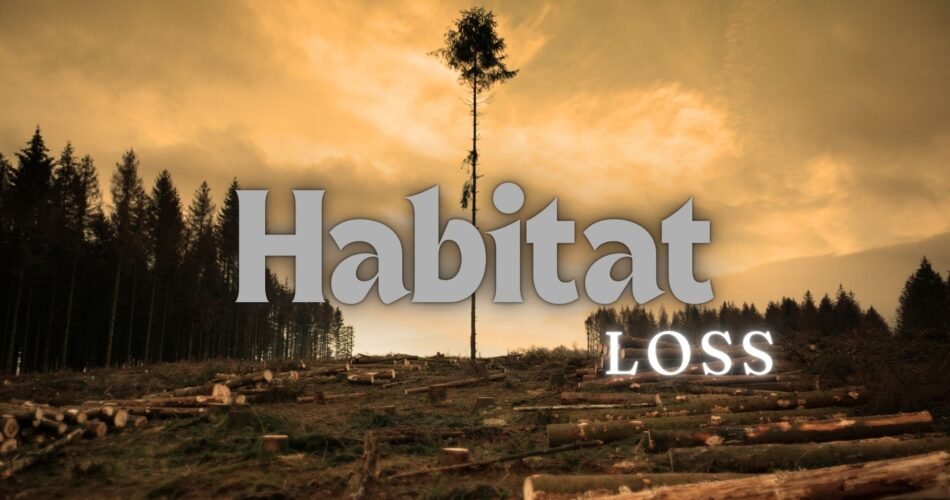This blog contains information about Habitat Loss. In the start, it provides the definition and introduction of a Habitat. It also mentions its Components with detail. Then it elaborates Habitat Loss. It also explain its Types. Then it discuss the main Causes of Habitat Loss. It also explain the Effects of Habitat loss. In the end, it elaborates the Prevention Strategies for Habitat loss. This blog contains Causes, Effects and Prevention of Habitat loss.
What does Habitat mean?
Habitat is defined as the natural environment in which an organism or a community of organisms lives. It includes all the biotic and abiotic factors of the certain location that helps them to survive.
We can say that habitat is the home of an organism that he uses to live throughout the year or a short period of time to find a mate. A habitat contains all the necessary physical properties essential for life of specific organism.
Habitat is any location or ecosystem which supports the life of an organism completely. For example, a suitable habitat for plants is a place where light, water, air and soil are exactly according to the needs of certain specie of plant and provide all Essential Nutrients for its growth and development.
In the same way, every living organism prefers to live in a place where all of their requirements for survival, are available. As we know that fish lives in water, rats live on land, crocodile lives both on land and in water. All of the animals lives in their specialized location.
Habitat is the most important component of life of a living organism. It is just as humans have their homes on suitable, healthy and aesthetic locations to live. No organism can survive without their Homes. The habitats of living organisms should be Protected and Conserved.
Important Components of a Habitat:
Following are the important components of a Habitat:
1. Shelter:
The most important component of a Habitat is shelter. The habitat should provide shelter for the organisms in order to save them from Environmental hazards and from different hunters. In case of animals, the habitat protects them from hunters and extreme weather conditions that can be life-threatening for them. The shelter can be in the form of other Biodiversity, Rocks. or Plants.
2. Water:
As we know that Water is essential for life of every organism. Every organism need different amounts of water to survive. If the habitat will not have water for the utilization of organisms to survive. For example, Fish lives in water, birds drink water to survive, plants need a lot of water to live and nourish etc. Availability of water is necessary for life of an organism, habitats with Water Scarcity or Water Crisis are failed by living organisms.
3. Food:
Same as water, food is also necessary to live and survive for living organisms. As all the living organisms need food to grow and develop properly. Most of the living organisms migrate to the places where their food is available in bulk. In the same way humans also prefer those places where there is availability of food because its their basic need. The habitats that are Food Insecure, are not safe for the living organism and animals migrate from those habitats in search of suitable habitat.
4. Space:
Another important requirement to live is space. If space will not be available for the living organisms, they cannot make it a habitat. For example, birds finds a branch of tree and makes their nest at any suitable location. So, space is needed for accommodation of an organism or community of the organisms. Even humans need space to live and all other organisms need space that should have food, water, and shelter to help them survive.
These are the important components of a Habitat. This blog contain Causes, Effects and Prevention of Habitat loss.

What is Habitat Loss?
Habitat loss is the condition that leads to the destruction in the area where specific species can survive. It can because of degradation of natural habitats or by Anthropogenic Activities.
We know the importance of habitat of organisms. The organisms that lost their habitats on Earth, are endangered or extinct. Habitat loss the biggest threat to wildlife as wildlife cannot survive in every basic environment and it needs special environments to grow and develop.
It is one of the most frequently occurred environmental issue of the present era. As human population is cause extreme land-use changes that are the major cause of habitat loss. Humans utilize different natural resources by ignoring the management of Biodiversity depending on those Natural Resources.
For example, if we remove one specie of plant from a forest because to human needs, we will observe that all the living organisms that were dependent on that specie will die or migrate in search of other habitats. This happens because the requirements for their habitats are not fulfilled. This condition will be Habitat loss.
Types of Habitat Loss:
Following are the Types of Habitat Loss:
i. Habitat Destruction:
Habitat destruction is a condition of habitat loss in which there is a significant change in the ecosystem that supports no native species. This may include massive removal of forest vegetation or can be abandonment of the forest.
ii. Habitat Fragmentation:
Habitat Fragmentation is the condition of Habitat Loss in which the previous amount of habitat becomes less and it supports a small number of species than before. There is a rise of smaller distributed pieces of habitats as the result of this condition.
iii. Habitat Degradation:
Habitat Degradation is that condition of Habitat Loss in which ecosystem is disrupted and disturbed but not destroyed. This condition increases difficulty for native species to live and survive in the habitat. This can be because of pollution, Nutrient loss, Desertification etc.
These are types of Habitat Loss.
Natural Causes of Habitat Loss:
Following are the natural causes of Habitat loss:
. Climate Change:
Climate Change is causing sudden and drastic changes in our environment. This phenomenon can make a habitat of certain species dried out or destroyed. It can be in the form of Global Warming with extreme temperatures or cooling at extremely freezing temperatures.
. Invasive Species:
Invasive species or non-native species can play a great role in habitat loss because they can disturb the living of native species. They can destroy vegetation at the habitat and can so make the habitat not able to live. Many habitats are destroyed because of invasive species.
. Natural Disasters:
Natural Disaster also abandon many of the habitats of living organisms. They include wetlands, islands, forests, crops and other such habitats. Natural disasters include Floods, Earthquakes, Tsunami, and many other disasters. These disasters damage the property and vegetation that comes in their way.
. Degradation:
The natural degradation of land can be due to any reason like soil erosion, soil salinity, nutrient loss etc. This degradation forces the species living there to migrate to other suitable locations that they can make their homes. Degradation can be triggered by Natural Disasters and Global Warming.
These are some Natural Causes of Habitat loss. This blog contains Causes, Effects and Prevention of Habitat Loss.
Anthropogenic Causes of Habitat Loss:
Following are the Anthropogenic Causes of Habitat Loss:
. Deforestation:
Deforestation is one of the biggest anthropogenic causes of Habitat loss. As we all know that forests are Biodiversity Hotspots and they contain thousands of rare flora and fauna. We are cutting the forests for making homes for humans by taking homes of many animals and plants. This is really unethical. Human activities are causing a great level of deforestation every year.
. Pollution:
Most of the habitats in present era are destructed because of excessive pollution. People have made the forests and agricultural lands, recreational places or dumpsters. They throw every type of waste in those areas and cause extreme pollution. This is totally a human’s responsibility to keep such habitats clean and green for the animals to live in.
. Agriculture:
We are using inefficient methods of agriculture by supplying chemical fertilizers and pesticides, by applying Intensive Farming and other such agricultural practices. This is taking away the natural property of soil to create and use fertility. This cause habitat loss of many plants and animals by making the soil and area poisonous for them to live.
. Land-use Change:
Due to Population growth, there is an extreme land-use change in present era. Because of Food Insecurity, the forests are converted into agricultural lands. On the other hand rich wetlands are converted into agricultural lands to grow food. This land-use change cause a great habitat loss because it removes the natural properties of the environments in which species live.
These are some of the Anthropogenic Causes of Habitat Loss.
Effects of Habitat Loss:
Following are the effects of Habitat Loss:
- Wildlife and other animals are open to Environmental Hazards.
- They do not get proper nutrition, shelter, space and water.
- Animals becomes open to all the dangers to their lives such as Hunters.
- Plants species cannot even migrate, they die at the spot as a result of Habitat degradation.
- Migrated animals mostly die in search of another habitat suitable for them.
- If they get a habitat, it takes time to become enough and suitable for them to live and survive.
- Animals face issues such as food insecurity, lack of shelter and protection, water shortage etc.
These are the effects of habitat loss on Biodiversity.
Prevention of Habitat Loss:
Following are the prevention strategies for Habitat Loss:
- Say no to deforestation.
- Avoid converting forests and other natural systems into artificial agricultural lands.
- Apply efficient agricultural and irrigation practices.
- Take proper care of Soil erosion and Soil Salinity.
- Carry out Restoration practices in forests and vegetative areas.
- Participate in cleaning natural biodiversity habitats.
- Avoid polluting forests and green spaces.
- Practice Afforestation and Reforestation to provide habitats to plants and animals.
- Try to restore habitats for species after Natural Disasters.
These are few prevention strategies for Habitat Loss. This blog contains Causes, Effects and Prevention of Habitat loss.

To learn about more topics, Click the links below:


Comments